Centromyrmex bequaerti
| Centromyrmex bequaerti | |
|---|---|

| |
| Scientific classification | |
| Kingdom: | Animalia |
| Phylum: | Arthropoda |
| Class: | Insecta |
| Order: | Hymenoptera |
| Family: | Formicidae |
| Subfamily: | Ponerinae |
| Tribe: | Ponerini |
| Genus: | Centromyrmex |
| Species: | C. bequaerti |
| Binomial name | |
| Centromyrmex bequaerti (Forel, 1913) | |
| Synonyms | |
| |
An obligate predator of termites that is frequently collected in termitaria.
Identification
A member of the bequaerti species group. This widespread species is worker polymorphic, polygynous and an obligate predator of termites, especially of the subfamilies Termitinae and Macrotermitinae (Dejean & Fénéron, 1996, 1999). These authors also describe the organisation of Centromyrmex bequaerti colonies within termitaries, saying that each queen of the polygynous colony, accompanied by a number of workers, occupies a separate chamber in the host termitary. From data labels of material examined bequaerti has been recorded from termitaries of the following genera: Amitermes, Coactotermes, Cubitermes, Furculitermes, Odontotermes, Trinervitermes and Tuberculitermes. Dejean et al. (1996, 1997) record it as common in nests of Cubitermes but the species was not found in nests of Procubitermes (Dejean & Bolton, 1995). It has also been collected from rotten logs and occasionally from samples of leaf litter. (Bolton and Fisher 2008)
Keys including this Species
Distribution
Latitudinal Distribution Pattern
Latitudinal Range: 6.762079° to -18.590717°.
| North Temperate |
North Subtropical |
Tropical | South Subtropical |
South Temperate |
- Source: AntMaps
Distribution based on Regional Taxon Lists
Afrotropical Region: Angola, Cameroun, Central African Republic, Democratic Republic of Congo (type locality), Gabon, Malawi, United Republic of Tanzania, Zambia, Zimbabwe.
Distribution based on AntMaps
Distribution based on AntWeb specimens
Check data from AntWeb
Countries Occupied
| Number of countries occupied by this species based on AntWiki Regional Taxon Lists. In general, fewer countries occupied indicates a narrower range, while more countries indicates a more widespread species. |

|
Estimated Abundance
| Relative abundance based on number of AntMaps records per species (this species within the purple bar). Fewer records (to the left) indicates a less abundant/encountered species while more records (to the right) indicates more abundant/encountered species. |

|
Biology
This widespread species is worker polymorphic, polygynous and an obligate predator of termites, especially of the subfamilies Termitinae and Macrotermitinae (Dejean & Fénéron, 1996, 1999). These authors also describe the organisation of Centromyrmex bequaerti colonies within termitaries, saying that each queen of the polygynous colony, accompanied by a number of workers, occupies a separate chamber in the host termitary. From data labels of material examined bequaerti has been recorded from termitaries of the following genera: Amitermes, Coactotermes, Cubitermes, Furculitermes, Odontotermes, Trinervitermes and Tuberculitermes. Dejean et al., (1996, 1997) record it as common in nests of Cubitermes, but the species was not found in nests of Procubitermes (Dejean & Bolton, 1995). It has also been collected from rotten logs and occasionally from samples of leaf litter. (Bolton and Fisher 2008)
Castes
Worker
Images from AntWeb
   
| |
| Worker. Specimen code casent0102992. Photographer April Nobile, uploaded by California Academy of Sciences. | Owned by NHMUK, London, UK. |
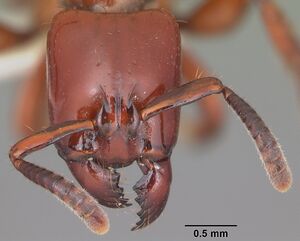   
| |
| Worker. Specimen code casent0104136. Photographer April Nobile, uploaded by California Academy of Sciences. | Owned by NHMUK, London, UK. |
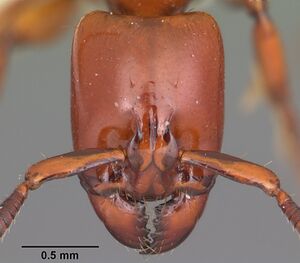 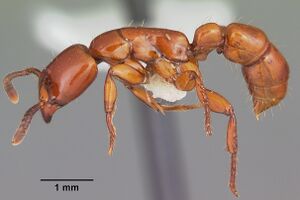 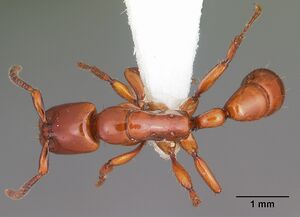 
| |
| Worker. Specimen code casent0104137. Photographer April Nobile, uploaded by California Academy of Sciences. | Owned by NHMUK, London, UK. |
   
| |
| Worker (major/soldier). Specimen code sam-hym-c007975a. Photographer April Nobile, uploaded by California Academy of Sciences. | Owned by SAMC, Cape Town, South Africa. |
Queen
 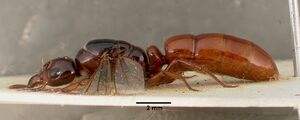       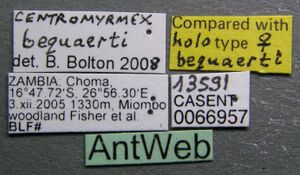
| |
| . | |
Nomenclature
The following information is derived from Barry Bolton's Online Catalogue of the Ants of the World.
- bequaerti. Glyphopone bequaerti Forel, 1913b: 308, fig. 1 (q.) DEMOCRATIC REPUBLIC OF CONGO.
- Type-material: holotype queen.
- Type-locality: Democratic Republic of Congo (“Congo belge”): Kasongo (Pons) = data on holotype label; Kibombo (J. Bequaert) = erroneously in text.
- Type-depository: MHNG.
- Wheeler, G.C. & Wheeler, J. 1976a: 48 (l.). Bolton & Fisher, 2008c: 11 (w.m.).
- Combination in Centromyrmex: Brown, 1963: 10.
- Status as species: Forel, 1913h: 347; Wheeler, W.M. 1922a: 766; Brown, 1963: 10; Bolton, 1995b: 140; Bolton, & Fisher, 2008c: 11 (redescription).
- Senior synonym of rufigaster: Brown, 1963: 10; Bolton, 1995b: 140; Bolton & Fisher, 2008c: 11.
- Distribution: Angola, Cameroon, Central African Republic, Democratic Republic of Congo, Gabon, Malawi, Zambia, Zimbabwe.
- rufigaster. Glyphopone (Leptopone) rufigaster Arnold, 1916: 163, figs. 10, 10a (q.) ZIMBABWE.
- Type-material: holotype queen.
- Type-locality: Zimbabwe (“S. Rhodesia”): Victoria Falls, 5.xii.1914 (G. Arnold).
- Type-depository: SAMC.
- Combination in Leptopone: Wheeler, W.M. 1922a: 766.
- Status as species: Wheeler, W.M. 1922a: 766.
- Junior synonym of bequaerti: Brown, 1963: 10; Bolton, 1995b: 140; Bolton & Fisher, 2008c: 11.
Unless otherwise noted the text for the remainder of this section is reported from the publication that includes the original description.
Description
Worker
Bolton and Fisher (2008) - TL 4.7-10.3, HL 0.99-2.04, HW 0.80-1.86, CI 81-93, ML 0.26-0.70, MI 28-38, SL 0.50-1.08, SI 60-68, PW 0.57-1.28, WL 1.50-2.84 (20 measured).
With characters of the genus and the bequaerti group. Mandible smooth, with scattered small pits and 5–7 teeth of which the apical is the largest. Number of teeth on mandible decreases with reduced size, from a maximum of 7 in largest workers to a minimum of 5 in smallest examined; the most common dental count is 5. Entire head, including ventral surface, smooth and shining, with scattered small pits. Bulla of metapleural gland conspicuous, low, its apex widely separated from the base of the propodeal spiracle. Protibia ventrally with a conspicuous single stout spiniform seta, similar to those on the mesotibia, this seta located close to the apex on its outer surface, anterior to and opposite the large spur. Spiniform setae present dorsally on mesotibia, mesobasitarsus, metatibia and metabasitarsus, most sparse on the metatibia. Petiole in largest workers (HW ca 1.86) with length of the tergite in profile 0.73 × the height of the tergite at its mid-length; in the smallest workers (HW ca 0.80) the length of the tergite in profile is 1.15 × the height of the tergite at its mid-length. In effect, the petiole tergite is higher than long in larger workers, longer than high in smaller workers. Mesosoma, petiole and gaster shiny, unsculptured except for setal pits and, in larger workers, some weak striation on the metapleuron. Pubescence almost absent, extremely sparse, short and inconspicuous except on pronotal collar, propleuron, and sternite of petiole. Colour yellow to deep dull red; smaller workers usually lighter in colour than larger workers.
Queen
Bolton and Fisher (2008) - TL 14.0-15.6, HL 1.96-2.24, HW 1.84-2.24, CI 96-100, OI 29-31, ML 0.74-0.84, MI 34-39, SL 1.14-1.26, SI 55-60, PW 1.85-2.25, WL 3.70-4.70 (5 measured). Somewhat larger than largest workers in associated series. Queens will run out to the correct species using the characters provided in the key to workers except for the position of the slit-shaped propodeal spiracle, which is somewhat lower on the side in queens than in workers.
Type Material
Bolton and Fisher (2008)- Holotype queen, DEMOCRATIC REPUBLIC OF CONGO: Kasongo (Pons) (Musee d'Histoire Naturelle Genève) [examined].
Glyphopone (Leptopone) rufigaster Holotype queen, ZIMBABWE: Victoria Falls (G. Arnold) (not in The Natural History Museum or South African Museum). The holotype of rufigaster cannot be found.
References
- Brown, W. L., Jr. 1963a. Characters and synonymies among the genera of ants. Part III. Some members of the tribe Ponerini (Ponerinae, Formicidae). Breviora 190: 1-10. (page 10, Combination in Centromyrmex, and senior synonym of rufigaster)
- Dejean, A. and R. Fénéron. 1996. Polymorphism and oligogyny in the ponerine ant Centromyrmex bequaerti (Formicidae: Ponerinae). Insectes Sociaux 43: 87-99.
- Dejean, A. and R. Fénéron. 1999. Predatory behaviour in the ponerine ant, Centromyrmex bequaerti: a case of termitolesty. Behavioural Processes 47: 125-133.
- Dejean, A., J. L. Durand and B. Bolton. 1996. Ants inhabiting Cubitermes termitaries in African rain forest. Biotropica 28: 701-713.
- Forel, A. 1913b. Formicides du Congo Belge récoltés par MM. Bequaert, Luja, etc. Rev. Zool. Afr. (Bruss.) 2: 306-351 (page 308, fig. 1 queen described)
- Nie, L., Zhao, F., Chen, Y., Xiao, Q., Pan, Z., Ran, H., Xu, Y. 2021. Prey status affects paralysis investment in the ponerine ant Harpegnathos venator. Insects 13, 26 (doi:10.3390/insects13010026).
- Bolton, B. and B. L. Fisher. 2008c. Afrotropical ants of the ponerine genera Centromyrmex Mayr, Promyopias Santschi gen. rev. and Feroponera gen. n., with a revised key to genera of African Ponerinae (Hymenoptera: Formicidae). Zootaxa 1929: 1-37. PDF
- Wheeler, G. C.; Wheeler, J. 1976a. Supplementary studies on ant larvae: Ponerinae. Trans. Am. Entomol. Soc. 102: 41-64 (page 48, larva described)
References based on Global Ant Biodiversity Informatics
- Bolton B., and B. L. Fisher. 2008. Afrotropical ants of the ponerine genera Centromyrmex Mayr, Promyopias Santschi gen. rev. and Feroponera gen. n., with a revised key to genera of African Ponerinae (Hymenoptera: Formicidae). Zootaxa 1929: 1-37.
- Bolton, B., and B. L. Fisher. "Afrotropical ants of the ponerine genera Centromyrmex Mayr, Promyopias Santschi gen. rev. and Feroponera gen. n., with a revised key to genera of African Ponerinae (Hymenoptera: Formicidae)." Zootaxa 1929 (2008): 1-37. Abstract
- Fisher B. L. 2004. Diversity patterns of ants (Hymenoptera: Formicidae) along an elevational gradient on Monts Doudou in southwestern Gabon. Memoirs of the California Academy of Sciences 28: 269-286.
- Forel A. 1913. Formicides du Congo Belge récoltés par MM. Bequaert, Luja, etc. Revue Zoologique Africaine (Brussels). 2: 306-351.
- IZIKO South Africa Museum Collection



